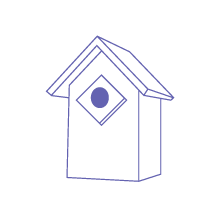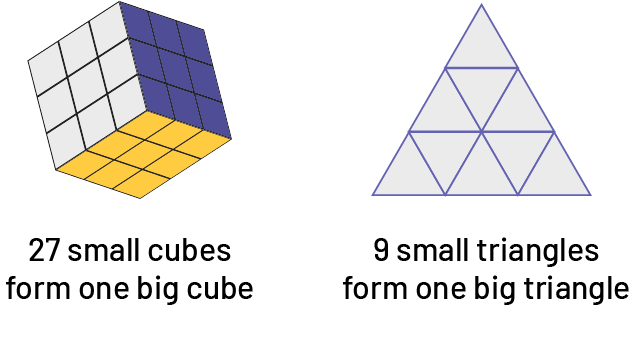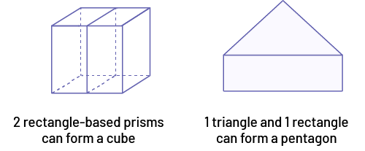E1.2 Construct three-dimensional objects, and identify two-dimensional shapes contained within structures and objects.
Skill: Building Three-Dimensional Objects
A toddler can have fun building (with Lego, wooden blocks, etc.), assembling (puzzles, shapes, etc.) and breaking down (cutting, folding, tearing drawings, etc.) different geometric shapes. At an early age, children realize that by stacking blocks, they can create a tower and by lining up blocks, they can create a wall. They may refer to their constructions as a tower and a wall because they see them as a whole.
Similarly, when observing objects in their environment, students first describe them as a whole and gradually name the parts and characteristics of certain attributes.
Example 1

The student will first say, "This is a birdhouse." Then they will say, "This is a birdhouse with a pointy roof, a round window, and smooth walls." When asked to reproduce the birdhouse with three-dimensional objects, the student realizes that they need different kinds of three-dimensional objects. A little later, the student will learn to name them.
At first, the child builds houses without naming the three-dimensional objects used. Later, they build a copy of a given model using three-dimensional objects. They may be able to identify cubes first, then prisms. The student will later be able to identify all the three-dimensional objects used.
Here are some possibilities of three-dimensional objects that can be used to build the birdhouse:
- a prism with triangular base and a prism with rectangular base;
- two cubes and two prisms with triangular base;
- five prisms with triangular base.
The number will vary depending on the size of the three-dimensional objects.
It is important to allow students to experiment and create freely as they build, assemble, or decompose geometric shapes for the first time, and to allow them to use a variety of materials or objects such as:
- wooden or plastic blocks of different shapes and sizes;
- modeling clay;
- straws, toothpicks, pipe cleaners;
- tiles;
- tangrams;
- pattern blocks;
- some string;
- newspapers.
Example 2
During guided activities, students will realize that:
- some shapes can be assembled to create the same shape, but of different size, for example:

- that some shapes can be assembled to form new shapes, for example:
 image Two shapes. The first shape is: "a rectangular prism." It’s labeled: "2 rectangular prisms can form a cube." The second picture is a: " pentagon. " It’s labeled: "a triangle and a rectangle can form a pentagon."
image Two shapes. The first shape is: "a rectangular prism." It’s labeled: "2 rectangular prisms can form a cube." The second picture is a: " pentagon. " It’s labeled: "a triangle and a rectangle can form a pentagon."
Construction, assembly, and decomposition activities help students understand several concepts related to geometric reasoning. For example, students deepen their understanding of edges and vertexes by building frameworks of three-dimensional objects, and their understanding of faces by building their shells.
Source: translated from Guide d’enseignement efficace des mathématiques de la 1re à la 3e année, Géométrie et sens de l'espace, p. 38-40.
Skill: Describing the Two-Dimensional Shapes That Make up a Three-Dimensional Object
In Kindergarten, children begin to describe, sort, classify, build and compare two-dimensional shapes and three-dimensional figures by exploring, and comparing their attributes and properties. For example, they might point to a triangle and say that it has three sides. In Grade 1, students begin to name geometric shapes.
Similarly, they can point to and name the vertices and sides of a two-dimensional shape and the vertices, edges, faces, and surfaces of a three-dimensional object.
Relationships Between Geometric Shapes
Activities in which students manipulate, construct, and decompose three-dimensional objects allow them to see the relationships between three-dimensional objects and their two-dimensional faces (for example, a cube is composed of square faces). When they understand that two-dimensional shapes are components of three-dimensional objects, students are able to decompose objects in their environment, assemble their own objects, and represent objects iconically or graphically.
Sorting three-dimensional objects allows students to focus on the two-dimensional faces that make up the three-dimensional object. During their initial experiments, students will use their own criteria or criteria suggested by teachers and discover that three-dimensional objects can be made up of "flat" or "curved" parts. This discovery will help them understand the faces of three-dimensional objects.
Building models of three-dimensional objects, such as prisms and pyramids, is another valuable learning experience that helps students understand that three-dimensional objects are made up of two-dimensional faces. When students build a model, for example, with play dough, they need to think about the shape of the three-dimensional object, and the shapes of its faces. Later in their school career, when they build models, students will need to visualize the geometric shapes that make up the model and the orientation of these shapes.
Source: translated from Guide d’enseignement efficace des mathématiques de la 1re à la 3e année, Géométrie et sens de l'espace, p. 15-16.
